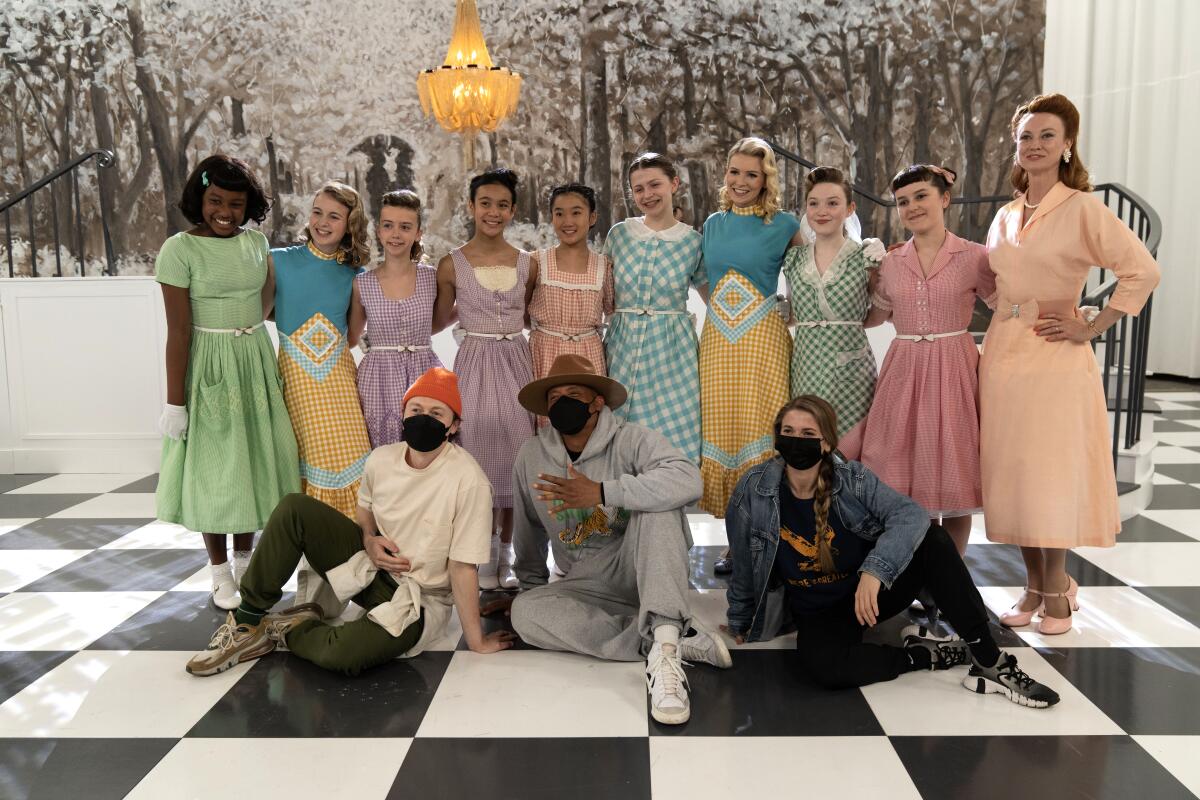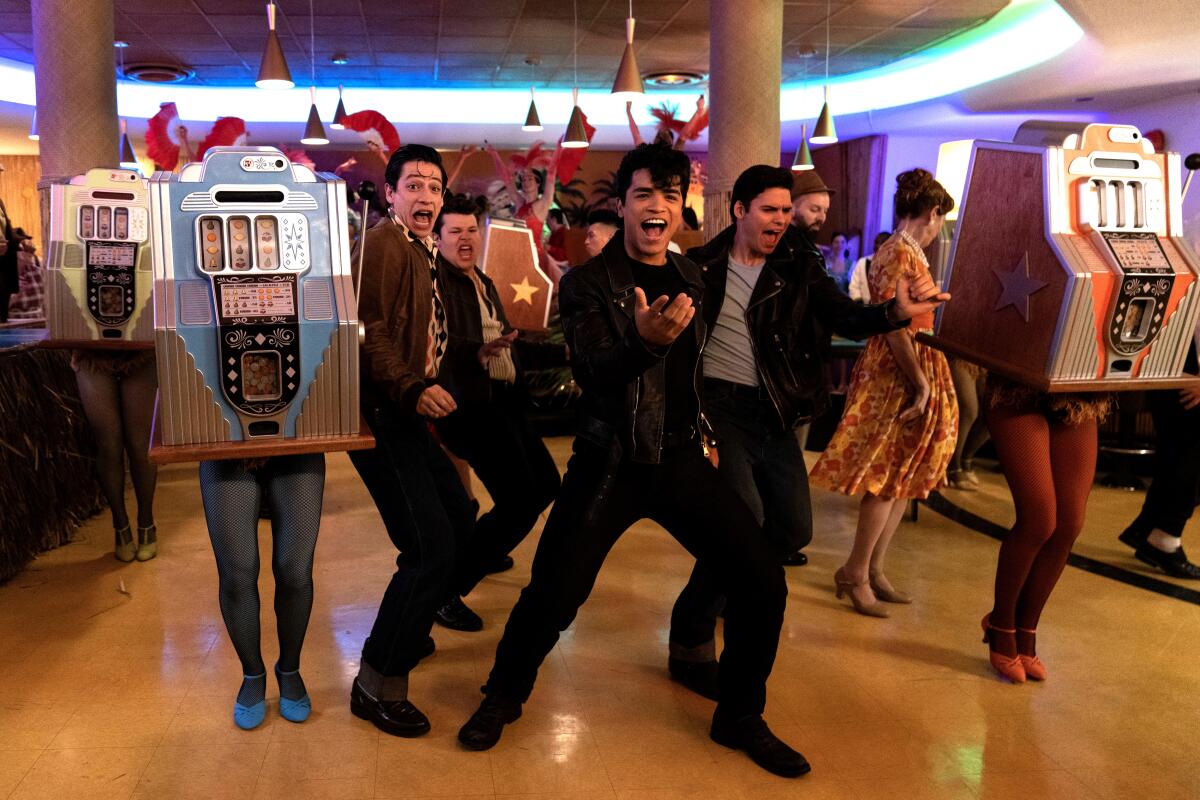Sign up for The Envelope
Get exclusive awards season news, in-depth interviews and columnist Glenn Whipp’s must-read analysis straight to your inbox.
You may occasionally receive promotional content from the Los Angeles Times.

Perhaps the biggest challenge facing the TV series “Grease: Rise of the Pink Ladies” was the inevitable comparison to its beloved predecessor, the 1978 megahit film “Grease,” especially the movie’s vivid musical sequences.
With so many iconic numbers from the film emblazoned in fans’ minds, the series, created by Annabel Oakes (original songs by Justin Tranter), had to find new ways to both honor and build upon the musical vibe of its wildly popular source material.
To that end, the show, set in 1954 (four years before the film), traces the origins of Rydell High’s plucky girl gang and its interactions with, among others, their male counterparts, the T-Birds. It takes a decidedly 2020s look at the 1950s, including an emphasis on diverse casting and storylines and such themes as female empowerment and gender equity, all of which often informed the series’ musical numbers. (Although Paramount+ did not renew “Pink Ladies” for a second season, its producer, Paramount Television Studios, buoyed by the show’s active fan base, is reportedly shopping the series elsewhere.)
Tranter, who’s written hits for the likes of Justin Bieber and Imagine Dragons, is executive music producer of ‘Grease: Rise of the Pink Ladies,’ premiering Thursday.
The Envelope spoke, via a lively group Zoom, with series choreographer Jamal Sims (an Emmy nominee for creating the routines for songs “New Cool,” “The Hand Jive” and “The Boom”) and associate choreographers Louise Hradsky and Jeffrey Mortensen (who earned a joint Emmy nod for their work on the numbers “Pulling Strings,” “Hit Me Again” and “High Rollin’”). The three discussed crafting and reimagining the show’s 1950s-set dance sequences for an all-new generation.
What was your first reaction when you learned you’d be working on a “Grease” prequel?
Louise Hradsky: It was so exciting: a musical television series full of dance. “Grease” is so iconic and we all grew up watching it and being inspired by it. So for the chance to dig into something that’s [now] a bit more gritty in content … it was exciting to know that we could approach creation with a little more maturity.

Jamal Sims: I have really great memories of the movie and of John Travolta as being somebody who inspired me to dance — it wasn’t too many times that we saw males dancing on screen! I knew all the choreography from “Grease” and “Grease 2” front to back, so the vocabulary that [the movies’ choreographer] Patricia Birch created kind of just lived in my bones. Having the opportunity to do this show was a way to pay homage to her and a way to push it even further.
Overall, how much were you guided by the choreography in the “Grease” movies?
Sims: [We] were really about the story first, trying to figure out, “What are we saying in these numbers and what are the plot points we are trying to hit in every sequence?” And then to make sure that all our characters had different ways of moving and different styles; that all the numbers looked different. Infusing the joy that the original “Grease” had, [its] fun and energy, was really important in creating these numbers as well.

Jeffrey Mortensen: The thing that is super important to me is, at the end of the musical sequence, what am I supposed to feel? What is the audience supposed to feel? And, like Jamal said, to make sure that the story is prismed through the “Grease” energy lens. You have that original Pat Birch choreography to reference … but this show is existing in the 2020s so there’s definitely a more modern lens of movement available to us to [reflect] the ‘50s or ‘70s patterns.
Jamal, “New Cool” and “The Hand Jive” are both based on famed numbers from “Grease” (“Greased Lightnin’” and “Born to Hand Jive,” respectively). How did you revamp the originals?
Sims: The fun part about “New Cool” is kind of exactly what the song is saying — it’s a new way of presenting this character, [Pink Lady] Cynthia, who’s discovering her sexuality. And sometimes it’s just about being yourself. Cynthia’s bold, she’s edgy and that was the thing I really wanted to come across: that this character doesn’t really care what anybody thinks. Whereas in “Greased Lightnin’” they’re talking about a car, [here] she’s talking about herself and these guys [the T-Birds].
Now when I heard we had to do “The Hand Jive,” I was like, “Oh, my God, you can’t touch [that].” But when we got the song, I understood this is the origin story. So we don’t have to compare it to the original, we just have to show how it was created. And that was the fun part.

Louise, any idea how the series’ seventh episode, on which you and Jeff served as lead choreographers, spawned all three of your Emmy-nominated numbers?
Hradsky: We were excited because when Episode 7 fell in our laps, it was really peeling back the layers of our “tough guy” characters. We had the opportunity through these songs and numbers to show their vulnerability. And I think what struck a chord with people is these are really emotional numbers … that are taking us deeper into the story of the T-Birds and our [student council president/quarterback/golden boy] Buddy character, whom we haven’t had a chance to know that deeply until now.
Feel like you’re missing more great TV than you can catch up on? Here’s a list of some under-the-radar shows you might want to check out.
Speaking of which, “Pulling Strings,” Buddy’s number about privilege, is quite unique — a little Fosse, a little “Spring Awakening.” How did you conceive that one?
Mortensen: What [actor] Jason [Schmidt] brings to Buddy is, like Louise said, a vulnerability which you didn’t often see in the 1950s. So we wanted to lean into that a little more — that sort of terror of who Buddy is as a man and what that means to him. It was our job to then take that vulnerability and physicalize it.
I think what’s so special about “Pulling Strings” are the transitions from scene to scene. There’s this seamless quality of sort of sleight of hand … or something pulling off these layers of who Buddy is. And Jason really ran with it.
Sign up for The Envelope
Get exclusive awards season news, in-depth interviews and columnist Glenn Whipp’s must-read analysis straight to your inbox.
You may occasionally receive promotional content from the Los Angeles Times.